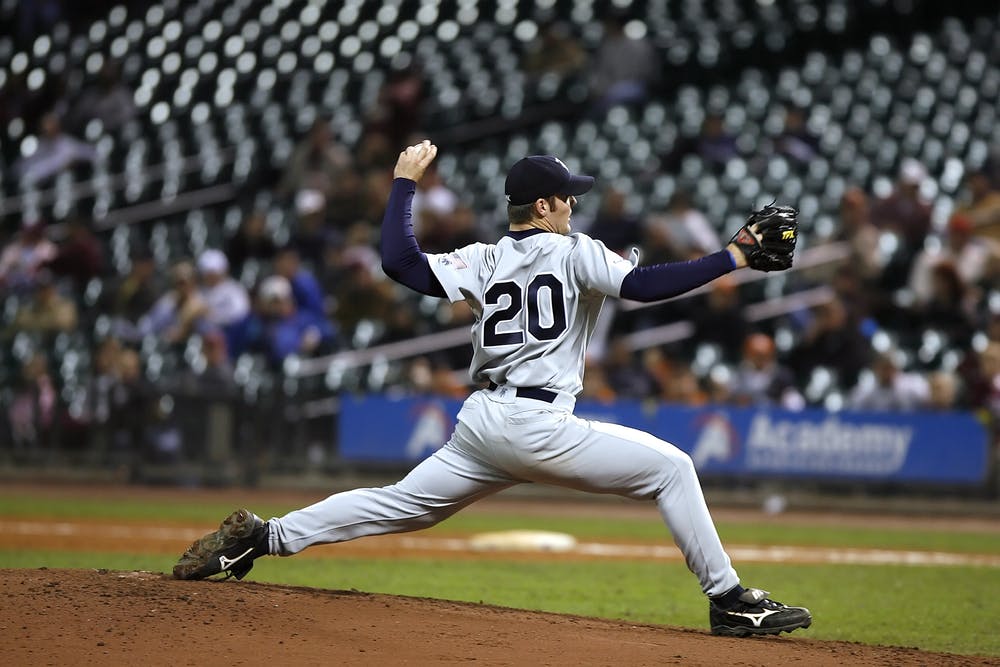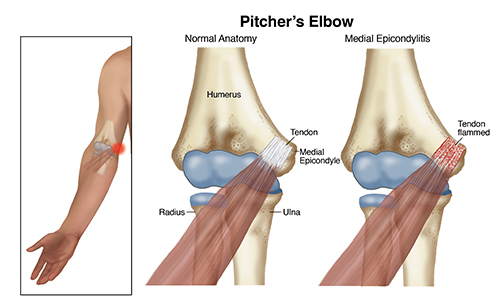|
BOOK NOW |
ASK ABOUT YOUR PAIN |
Home > Blog > Physiotherapy & Hand Therapy > Conditions > Elbow Pain > Pitcher's Elbow (Medial Apophysitis) Physiotherapy
Pitcher's Elbow (Medial Apophysitis) Physiotherapy

Medial apophysitis, or pitcher's elbow, refer to a painful elbow condition that occurs as a result of an injury or irritation to the inside of the elbow, and it commonly affect young athletes.
It is often classified as an "overuse syndrome" in baseball or softball players in the developmental stages of rapid growth (approximately 11 to 15 years of age).
Pitcher’s elbow can
be identified and effectively treated by our senior physiotherapists and/or senior hand therapists.
What is Medial Apophysitis?
Pitcher's elbow occurs when there is irritation to the inside portion of the elbow joint where the arm bone (humerus) meets one of the bones of the forearm (ulna).
During adolescence, the bones that form the elbow joint are still developing and are, therefore, more susceptible and at risk to developing injuries.
During the throwing motion, stress is put on this part of the elbow.
When too much stress is present (ie, from too much throwing) and when the joint is not able to recover properly (ie, when there is not enough rest time between periods of activity), the elbow can become injured, resulting in an elbow that is painful and swollen - this leads to the athlete being unable to throw with speed and accuracy at their normal volume.
Pitcher's elbow can start gently as soreness, but if not diagnosed and treated early on, can progress to more serious injuries, such as tearing of the ligaments or fracture of the bone(s) of the joint.

How Does it Feel?
With pitcher's elbow, you may experience:
- Gradually worsening pain at the inside of your elbow when throwing a ball
- Lingering soreness at the inside of your elbow following throwing activities
- Swelling and tenderness around the inside area of the elbow area
- Inability to throw the ball at your normal speed
- Loss of grip strength
- Loss of accuracy or distance when throwing
- Muscle cramping in your forearm
- Loss of motion of your elbow
- Discomfort with daily activities that use your forearm muscles, like turning a doorknob or carrying a heavy object in front of you
How Is It Diagnosed?
Diagnosis of pitcher's elbow begins with a thorough review of the athlete's medical history, including specific questions regarding athletic participation
- sports played
- frequency of practices and games
- positions
- types
- numbers of pitches thrown
Our senior physiotherapist will assess different measures, such as sensation, motion, strength, flexibility, tenderness, and swelling.
Then we will perform several tests specific to the elbow joint to examine the structures located there, and may ask you to briefly demonstrate the activities or positions that cause your pain.
Depending on your symptoms, we may even ask you to throw a baseball or softball to assess your throwing mechanics. We will also ask you to give detailed information about your experience as a throwing athlete.
Because the shoulder and elbow are both involved in throwing, we will likely examine your shoulder. Other nearby areas, such as your neck and upper back, will also be examined to determine whether they, too, might be contributing to your elbow condition.
If we suspect there may be a more involved injury than overuse-related irritation (ie, if there is a recent significant loss of elbow motion or severe pain when the elbow is moved), we may recommend a referral to an orthopedic physician for diagnostic imaging, such as
- diagnostic ultrasound
- x-ray
- MRI
All aspects of diagnosis, including subjective questioning, the clinical exam, and diagnostic imaging are important to determine the nature of your elbow injury.
how our senior physiotherapists and senior hand therapists can help
Once other conditions have been ruled out and pitcher’s elbow is diagnosed, we will work with you to develop an individualized plan tailored to your specific elbow condition and your athletic goals.
There's a few physiotherapy treatments that have been shown to be very effective in treating this condition.
We may focus on:
Range of Motion
Because of the repetitive nature of throwing that causes the elbow to be irritated, it is often swollen and stiff, resulting in a loss of normal motion.
You may also have abnormal motion of your throwing shoulder that is contributing to the way your elbow is acting during throwing.
We will assess the motion of both of these joints compared to expected normal motion for your age and gender, as well as that of your other shoulder and elbow.
Strength Training
The muscles surrounding the shoulder and elbow as well as those of the upper back, work together to allow for normal, coordinated upper-body motion. This coordinated motion is especially important during throwing.
Therefore, balancing the strength of all the upper-body muscles is crucial to making sure the shoulder and elbow joints move efficiently.
We will teach you exercises to strengthen the muscles around the shoulder, so that each muscle is able to properly perform its job, and stresses are appropriately dispersed.

Manual Therapy
Our senior physiotherapists are trained in manual (hands-on) therapy.
If needed, we will gently move and mobilize your elbow and shoulder joint and surrounding muscles as needed to improve their motion, flexibility, and strength. These techniques can target areas that are difficult to treat on your own.
We may recommend therapeutic modalities, such as
- cold therapy
- heat therapy
- ultrasound therapy
- radio-frequency Indiba physiotherapy
- deep tissue release
- dry needling
Functional Training
In the adolescent age group that typically suffers from pitcher’s elbow, an athlete is usually learning how to adapt their movements to a growing body. Poor coordination can place undue stress on the shoulder and elbow, and improper movements can, over time, cause cumulative damage and pain in the body.
Our senior physiotherapists are experts in assessing movement quality, and in training athletes to function at their best. We will point out and correct faulty movements in your throwing motion, so you are able to attain and maintain a pain-free elbow.